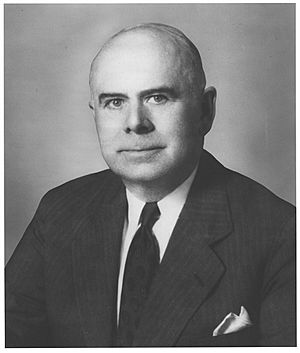Thomas Harris MacDonald facts for kids
Quick facts for kids
Thomas Harris MacDonald
|
|
|---|---|

Thomas Harris MacDonald
|
|
| Administrator of the Federal Highway Administration | |
| In office April 1, 1919 – March 31, 1953 |
|
| Preceded by | Logan Waller Page |
| Succeeded by | Francis Victor du Pont |
| Personal details | |
| Born | July 23, 1881 Leadville, Colorado |
| Died | April 7, 1957 (aged 75) College Station, Texas, U.S. |
| Nationality | American |
| Residence | U.S. |
| Alma mater | Iowa State University |
Thomas Harris "Chief" MacDonald (born July 23, 1881 – died April 7, 1957) was a very important American engineer. He had a huge impact on building the Interstate Highway System in the United States. He was in charge of the Bureau of Public Roads for 34 years, from 1919 to 1953.
During his time, he worked with seven different U.S. Presidents. He helped create 3.5 million miles of highways! He also personally led the building of the Alaskan Highway. Plus, he helped countries in Central America build the Inter-American Highway. Even though he was very powerful, many Americans didn't know who he was.
Contents
About Thomas MacDonald
Thomas MacDonald was born in a log cabin in Leadville, Colorado. His family moved back to Poweshiek County, Iowa when he was young. His father worked with grain and lumber. Young Thomas saw how bad the local roads were. It was hard to move lumber in wagons, especially when the roads were muddy in spring and fall.
Most people at that time thought railroads were the answer for transportation. But Thomas wanted to learn about building roads. He went to Iowa State College (now Iowa State University) to study civil engineering. He graduated in 1904.
Starting His Career
After college, Thomas became an assistant for road investigations at the Iowa State Highway Commission. He quickly became the chief engineer and then the Iowa highway commissioner. He was later chosen to be the president of the American Association of State Highway Officials (AASHO).
When he was 38, this group suggested he lead the Bureau of Public Roads. Congress quickly agreed. He asked for a higher salary, and he got it. He also made sure that road construction started as quickly as possible.
Building Partnerships
MacDonald brought together many different groups to support road building. These included companies that made cement and rubber, car clubs, and other road-building associations.
He was a very serious person. One person who worked for him said, "When you were in Mr. MacDonald's presence you were quiet." He was also very dedicated to his work. He believed that building roads was one of the most important public responsibilities, right after educating children.
Spreading the Word About Roads
MacDonald was very good at convincing people about the importance of roads. He started what was called a "propaganda campaign" to argue that good roads were a basic right. He gave radio speeches as early as 1923.
He also created groups like the Highway Education Board (HEB). This group pretended to be independent, but it worked with the Bureau of Public Roads. The HEB created materials for schools, held contests, and published booklets. MacDonald worked closely with industries that would benefit from roads to get more money for his federal budget.
He also convinced Congress to let him sign contracts with states. These contracts promised states money for roads. The U.S. Government then had to keep these promises. President Franklin D. Roosevelt tried to stop MacDonald from having this power, but he couldn't.
Later Years and Legacy
Near the end of his career in 1947, MacDonald suggested that cities should encourage people to use public transportation more. He felt that too many private cars would make traffic problems impossible to solve in big cities.
However, it was too late for that idea to take hold. In 1953, President Dwight D. Eisenhower asked him to resign. Thomas MacDonald died in College Station, Texas in 1957.
In 1949, another famous builder, Robert Moses, said that the Public Roads Administration under Thomas H. MacDonald was a great example of how federal, state, and local governments could work well together.
See also
- Robert Moses
- The Power Broker
- Herbert S. Fairbank

